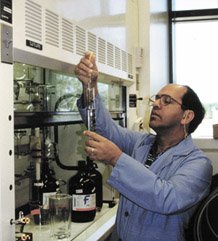Label Review Training: Module 2: Parts of the Label, Page 2
Section 1: What is on the front panel?
By the end of this section, you will be able to:
- Describe the eight label parts that appear on a pesticide label's front panel.
- Identify the part of a label's front panel that will be affected if a product is subject to the Worker Protection Standard.
- Organize the eight label parts in the approximate order in which they appear on the label.
Front Panel Label Parts
The front panel of a pesticide label can include the parts listed below. Note that not all of these parts must appear on every label. Module 3 provides further information about specific requirements for the individual label parts.
- Restricted use pesticide statement
If a pesticide's toxicity exceeds certain hazard criteria, then the pesticide is classified as a restricted use pesticide (RUP). RUPs require an RUP statement enclosed in a box, which must be at the top of the front panel with nothing above it. The statement includes the following elements in the following order:1. The heading “Restricted Use Pesticide.”
2. A reason for the restricted use classification.
3. A summary statement of the terms of restriction. - Product name, brand, or trademark

The product name, brand, or trademark identifies the product. Product names cannot constitute false and misleading claims. An example of a misleading product name is, “SAF-T-OIL.” “SAF-T-OIL” is misleading because it makes an implied safety claim. - Ingredient statement The ingredient statement identifies the name and the percentage by weight of each active ingredient and the percentage by weight (but generally not the names) of other/inert ingredients.
- Child hazard warning statement
The child hazard warning statement (“Keep Out of Reach of Children”) appears on almost all end-use pesticide products except those pesticides that are intended for use on children or where it is demonstrated that children will not come in contact with the products. In these cases, a modified statement is allowed. It is also referred to as the Keep Out of Reach of Children (KOROC) statement. - Signal word
Acute toxicity studies examine a product's toxicity as it relates to six different types of exposures (acute oral, acute dermal, acute inhalation, primary eye irritation, primary skin irritation, and dermal sensitization). The product is assigned a toxicity category (I–IV) for each type of exposure based on the results of five of the six studies. (The sixth study, for dermal sensitization, evaluates the potential for allergic contact dermatitis. Its results are either positive or negative and do not affect the signal word.) A product's signal word is determined by the most severe toxicity category assigned any of the five acute toxicity studies, or the presence of methanol in concentrations of 4 percent or more. The signal words and associated toxicity categories are as follows:1. Toxicity Category I: DANGER
If methanol is present in concentrations of 4 percent or more, the signal word, regardless of the toxicity categories noted in the acute toxicity review, must be “Danger.”
2. Toxicity Category II: WARNING
3. Toxicity Category III: CAUTION
4. Toxicity Category IV: None Required
- Skull and crossbones symbol and the word “Poison”

The skull and crossbones symbol and the word “Poison” identify pesticide products that are determined to be in Toxicity Category I based on at least one of the following acute toxicity studies: acute oral, acute dermal, or acute inhalation. They are also required if methanol is present at 4 percent or more. - First aid statement
First aid statements provide information to the pesticide user concerning appropriate first aid for the various routes of exposure associated with accidental exposure. First aid statements include instructions for the user, instructions for the physician, and a telephone number to call for emergency information. Regulations allow the first aid statement to be placed on another panel of the label.
A first aid statement is required when any acute toxicity study result is classified as category I, II, or III. It is acceptable for the registrant to include first aid statements for study results that are classified as category IV. - Net contents/net weight
The net contents/net weight section identifies the weight or volume of pesticide in the container. The net contents/net weight quantity:- Must be expressed in conventional U.S. units of measurement.
- Must not include any wrappers or other packaging materials.
- Must be stated in terms of the largest suitable units. (For example, “1 pound 10 ounces” rather than “26 ounces.”)
- Must be consistent with directions for use. The label's directions for use should not require a quantity of pesticide product that exceeds the net contents/net weight of the package.
Resources
For more information about the front panel, see Chapter 3, Section VII.A of the Label Review Manual.
To learn about appropriate type sizes for front panel warning statements, see Chapter 3, Section VIII of the Label Review Manual.
For more information about labeling requirements for restricted use pesticides, see Chapter 6, Section III.B–C of the Label Review Manual.
For more information on false or misleading product names, see Chapter 12, Section VI of the Label Review Manual.
For more information about ingredient statements, see Chapter 5 of the Label Review Manual.
For more information about precautionary statements, including child hazard warning statements, signal words, first aid statements, and the skull and cross bones symbol, see Chapter 7 of the Label Review Manual.
For more information about net weight/net contents, see Chapter 17 of the Label Review Manual.
Page 2 of 16
Previous Page Next Page
